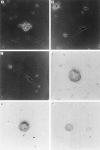Presence of circulating abnormal CD34+ progenitors in adult Langerhans cell histiocytosis
- PMID: 10403933
- PMCID: PMC1905468
- DOI: 10.1046/j.1365-2249.1999.00950.x
Presence of circulating abnormal CD34+ progenitors in adult Langerhans cell histiocytosis
Abstract
Langerhans cell histiocytosis (LCH) is related to the proliferation of cells, which are similar to Langerhans cells (LC) but possess many abnormal characteristics. Lesions are widespread and this fact suggests that LCH cells or their precursors are present in the blood of patients. In five adult patients, we have isolated and cultured CD34+ blood progenitors of dendritic cells. We studied their phenotype by flow cytometry and their functional properties in mixed culture with heterologous lymphocytes and with autologous lymphocytes in the presence of tri-nitro-phenyl antigen (TNP). The amount of CD34+ precursors was dramatically higher than controls but a high mortality occurred during the in vitro differentiation. The phenotype of surviving cells was similar to LC phenotype (CD1a+, CD83+, Lag+) but some of them expressed CD2. These cells were able to induce T cell proliferation in mixed culture. They could not initiate primary response to TNP, except in a patient treated with thalidomide. In our hands, these CD34+ cells may be precursors of LCH cells.
Figures



Similar articles
-
CSF1R Is Required for Differentiation and Migration of Langerhans Cells and Langerhans Cell Histiocytosis.Cancer Immunol Res. 2020 Jun;8(6):829-841. doi: 10.1158/2326-6066.CIR-19-0232. Epub 2020 Apr 1. Cancer Immunol Res. 2020. PMID: 32238382
-
CD34+ hematopoietic progenitors from human cord blood differentiate along two independent dendritic cell pathways in response to GM-CSF+TNF alpha.J Exp Med. 1996 Aug 1;184(2):695-706. doi: 10.1084/jem.184.2.695. J Exp Med. 1996. PMID: 8760823 Free PMC article.
-
Macrophage colony-stimulating factor in cooperation with transforming growth factor-beta1 induces the differentiation of CD34+ hematopoietic progenitor cells into Langerhans cells under serum-free conditions without granulocyte-macrophage colony-stimulating factor.J Invest Dermatol. 2003 Feb;120(2):256-65. doi: 10.1046/j.1523-1747.2003.12036.x. J Invest Dermatol. 2003. PMID: 12542531
-
[Recent data and current studies of epidermal Langerhans cells].Pathol Biol (Paris). 1995 Dec;43(10):841-7. Pathol Biol (Paris). 1995. PMID: 8786888 Review. French.
-
[The Langerhans cell: from in vitro production to use in cellular immunotherapy].J Soc Biol. 2001;195(1):69-74. J Soc Biol. 2001. PMID: 11530504 Review. French.
Cited by
-
Cell-specific gene expression in Langerhans cell histiocytosis lesions reveals a distinct profile compared with epidermal Langerhans cells.J Immunol. 2010 Apr 15;184(8):4557-67. doi: 10.4049/jimmunol.0902336. Epub 2010 Mar 10. J Immunol. 2010. PMID: 20220088 Free PMC article.
-
Indeterminate cell histiocytosis: a case report.Kaohsiung J Med Sci. 2004 Jan;20(1):24-30. doi: 10.1016/S1607-551X(09)70080-4. Kaohsiung J Med Sci. 2004. PMID: 15481563 Free PMC article.
-
Successful treatment of adult Langerhans cell histiocytosis with intensified chemotherapy.Int J Hematol. 2015 Aug;102(2):244-8. doi: 10.1007/s12185-015-1778-0. Epub 2015 Mar 10. Int J Hematol. 2015. PMID: 25753226
-
New insights into the molecular pathogenesis of langerhans cell histiocytosis.Oncologist. 2014 Feb;19(2):151-63. doi: 10.1634/theoncologist.2013-0341. Epub 2014 Jan 16. Oncologist. 2014. PMID: 24436311 Free PMC article.
References
-
- Cline MJ. Histiocytes and histiocytosis. Blood. 1995;84:2840–53. - PubMed
-
- Lichtenstein L. Integration of eosinophilic granuloma of bone, Letterer–Siwe disease and Schüller–Christian disease as related manifestations of a single nosologic entity. Arch Pathol. 1953;56:84–102. - PubMed
-
- Misery L, Lyonnet S, Cambazard F, Faure M. Encyclopidie médico-chirurgicale-dermatologie. 12-798-A-10. Paris: Editions Techniques; 1993. Histiocytose X (histiocytose langerhansienne) p. 5.
-
- Malpas JS, Norton AJ. Langerhans cell histiocytosis in the adult. Med Ped Oncol. 1996;27:540–6. - PubMed
-
- Cambazard F, Misery L, Kanitakis J, Archimbaud E, Hemier C. Acute monoblastic leukemia and histiocytosis X: a case report and review of the literature. Eur J Dermatol. 1991;1:11–17.
Publication types
MeSH terms
Substances
LinkOut - more resources
Full Text Sources
Medical

